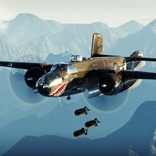War Thunder: An Unparalleled Aviation and Armored Warfare Experience
Introduction
War Thunder, developed by Gaijin Entertainment, stands as a monumental entry in the realm of military combat simulators. Since its release in 2012, this free-to-play game has carved out a niche for itself, offering a meticulously detailed and expansive experience for fans of aerial and armored warfare. With continuous updates and a dedicated player base, War Thunder has evolved into a comprehensive simulation that appeals to both casual players and hardcore enthusiasts.
Gameplay and Mechanics
At its core, War Thunder is a multifaceted game that combines realistic flight simulation with ground-based combat. Players can engage in battles featuring a vast array of vehicles, including aircraft, tanks, and naval vessels from World War II to the Cold War period. The game excels in providing a diverse range of battle scenarios, each meticulously designed to offer a unique challenge.
The aviation aspect of War Thunder is particularly impressive. The flight mechanics are detailed, offering a high degree of realism while still remaining accessible to newcomers. Pilots can engage in dogfights, execute complex maneuvers, and utilize a range of aircraft from various nations. The attention to detail in aircraft modeling and damage systems enhances the immersive experience, making each battle feel authentic.
On the ground, War Thunder’s tank battles are equally captivating. The game features a wide selection of armored vehicles, each with distinct characteristics and weaponry. The combat is strategic, requiring players to consider factors such as armor penetration, terrain, and positioning. The dynamic weather and environmental effects further contribute to the realism of tank warfare.

Graphics and Audio
War Thunder's graphics are a standout feature, offering stunning visuals that capture the essence of World War II and Cold War-era battles. The attention to detail in vehicle models, landscapes, and environmental effects is impressive, creating an immersive experience that draws players into the conflict. The game’s graphics engine handles large-scale battles with ease, maintaining performance even during intense skirmishes.
Progression and Customization
War Thunder’s progression system is well-structured, offering a sense of accomplishment as players unlock new vehicles, upgrades, and customization options. The game employs a tiered progression model, allowing players to gradually access more advanced equipment as they advance through the ranks. The customization options for vehicles and aircraft add a personal touch, enabling players to tailor their machines to their preferences. The War Thunder community is active and engaged, with a wealth of forums, guides, and player-generated content available.

 6250
Play
6250
Play
Challenges and Criticisms
Despite its many strengths, War Thunder is not without its challenges. The complexity of its mechanics can be daunting for new players, and the learning curve may deter some from fully enjoying the game. Additionally, the monetization model, while typical for free-to-play games, has faced criticism for its potential impact on game balance and player progression.
Community and Support
Gaijin Entertainment has fostered a strong support system, with regular updates, patches, and events that keep the game fresh and exciting. The developers’ commitment to listening to player feedback and implementing changes reflects a dedication to improving the overall experience.
Conclusion
War Thunder stands as a testament to the depth and versatility of modern military simulators. Its blend of detailed vehicle mechanics, realistic combat, and stunning visuals creates an engaging and immersive experience for players. While it may present a steep learning curve and face some criticisms regarding its monetization model, its strengths far outweigh its shortcomings. For those with a passion for military history and combat simulation, War Thunder remains a compelling and unparalleled experience in the genre.


